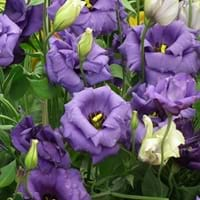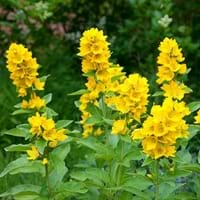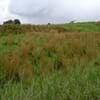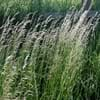Life Span
Biennial
Perennial
Type
Flowering Plants, Grass, Herbs
Perennial
Origin
Southwestern United States, Mexico
Eastern Europe, Turkey
Types
'Balboa White' lisianthus, 'Forever Blue' lisianthus, 'Forever White' lisianthus, 'Lisa Pink' lisianthus
creeping Jenny, L. ephemerum
Number of Varieties
Not Available
Habitat
Grassland, Warmer regions
damp broad-leaved forests, damp meadows, ditches, roadside embankments, shores, stream banks
USDA Hardiness Zone
8-11
4-8
Sunset Zone
1a, 1b, 2a, 2b, 3a, 3b, 4, 5, 6, 7, 8, 9, 10, 11, 12, 13, 14, 15, 16, 17, 18, 19, 20, 21, 22, 23, 24
1a, 1b, 2a, 2b, 3a, 3b, 4, 5, 6, 7, 8, 9, 14, 15, 16, 17, 18, 19, 20, 21, 22, 23, 24
Habit
Upright/Erect
Upright/Erect
Minimum Height
Not Available
Minimum Width
Not Available
Flower Color
White, Blue, Pink, Lavender, Blue Violet
Yellow
Flower Color Modifier
Bicolor
Bicolor
Fruit Color
Not Available
Not Available
Leaf Color in Spring
Gray Green
Green, Dark Green
Leaf Color in Summer
Gray Green
Green, Dark Green
Leaf Color in Fall
Gray Green
Green, Dark Green
Leaf Color in Winter
Gray Green
Light Green
Leaf Shape
Succulent
Long Linear
Plant Season
Spring, Summer
Summer
Sunlight
Full Sun, Partial Sun
Full Sun, Partial Sun, Partial shade
Type of Soil
Clay, Loam, Sand
Clay, Loam
The pH of Soil
Neutral, Alkaline
Acidic, Neutral, Alkaline
Soil Drainage
Well drained
Well drained
Bloom Time
Spring, Late Spring, Early Summer, Summer, Late Summer
Late Spring, Early Summer
Tolerances
Not Available
Drought
Where to Plant?
Container, Ground, Pot
Container, Ground, Pot
How to Plant?
Seedlings, Stem Planting
Divison, Seedlings
Plant Maintenance
Medium
Medium
Watering Requirements
Form a Soil ring to water efficiently, It cannot sustain wet-feet, Keep the ground moist but not water-logged, Use Mulches to help prevent water loss during hot and windy weather, Water twice a day in the initial period
Keep the ground moist but not water-logged, Requires consistently moist soil
In Summer
Lots of watering
Lots of watering
In Spring
Moderate
Moderate
In Winter
Average Water
Average Water
Soil pH
Neutral, Alkaline
Acidic, Neutral, Alkaline
Soil Type
Clay, Loam, Sand
Clay, Loam
Soil Drainage Capacity
Well drained
Well drained
Sun Exposure
Full Sun, Partial Sun
Full Sun, Partial Sun, Partial shade
Pruning
Cut or pinch the stems, Prune ocassionally, Remove dead or diseased plant parts, Remove deadheads
Remove damaged leaves, Remove dead branches
Fertilizers
All-Purpose Liquid Fertilizer
All-Purpose Liquid Fertilizer, organic fertlizers, slow-release fertilizers
Pests and Diseases
Botrytis Blight, Cercospora leaf spot, Cucumber mosaic, Curvularia blotch, Downy mildew, Fusarium stem rot, Fusarium wilt, Impatiens necrotic spot, Lisianthus necrosis, Phyllosticta leaf spot, Pythium root rot, Rhizoctonia stem rot, Sclerophoma stem blight, Tobacco mosaic
Slugs, Snails
Plant Tolerance
Drought
Drought
Flower Petal Number
Single, Double, Semi-Double
Single
Foliage Texture
Medium
Coarse
Foliage Sheen
Matte
Matte
Attracts
Bees, Butterflies
Birds, Butterflies, Hummingbirds
Allergy
Chest tightness, Diarrhea, Dizziness, Nausea, Vomiting
Skin irritation
Aesthetic Uses
Beautification, Bouquets, Showy Purposes, Used for decorating walls, fences, gates, hedges, etc.
Showy Purposes
Beauty Benefits
Not Available
Not Available
Environmental Uses
Air purification
Not Available
Medicinal Uses
Not Available
Astringent, Diarrhea, Dysentry, Gastrointestinal disorders
Part of Plant Used
Flowers
Whole plant
Other Uses
Showy Purposes, Used for fragrance
Used for its medicinal properties
Used As Indoor Plant
Yes
No
Used As Outdoor Plant
Yes
Yes
Garden Design
Bedding Plant, Container, Cutflower, Mixed Border, Wildflower
Groundcover, Mixed Border, Wildflower
Botanical Name
EUSTOMA grandiflorum
LYSIMACHIA punctata
Common Name
Lisianthus
Yellow Loosestrife, garden loosetrife, garden yellow loosetrife
In Hindi
Lisianthus
Yellow Loosestrife
In German
Lisianthus
Gilbweiderich
In French
Lisianthus
salicaire Jaune
In Spanish
Lisianthus
Lisimaquia amarilla
In Greek
Lisianthus
κίτρινο loosestrife
In Portuguese
Lisianthus
Loosestrife amarelo
In Polish
Eustoma
żółty toje
In Latin
Lisianthus
Yellow Loosestrife
Phylum
Magnoliophyta
Anthophyta
Class
Magnoliopsida
Equisetopsida
Order
Gentianales
Primulales
Family
Gentianaceae
Primulaceae
Clade
Angiosperms, Asterids, Eudicots
Angiosperms, Asterids, Eudicots
Tribe
Not Available
Not Available
Subfamily
Not Available
Not Available
Number of Species
Not Available
Season and Care of Lisianthus and Yellow Loosestrife
Season and care of Lisianthus and Yellow Loosestrife is important to know. While considering everything about Lisianthus and Yellow Loosestrife Care, growing season is an essential factor. Lisianthus season is Spring and Summer and Yellow Loosestrife season is Spring and Summer. The type of soil for Lisianthus is Clay, Loam, Sand and for Yellow Loosestrife is Clay, Loam while the PH of soil for Lisianthus is Neutral, Alkaline and for Yellow Loosestrife is Acidic, Neutral, Alkaline.
Lisianthus and Yellow Loosestrife Physical Information
Lisianthus and Yellow Loosestrife physical information is very important for comparison. Lisianthus height is Not Available and width Not Available whereas Yellow Loosestrife height is 60.00 cm and width 120.00 cm. The color specification of Lisianthus and Yellow Loosestrife are as follows:
Lisianthus flower color: White, Blue, Pink, Lavender and Blue Violet
Lisianthus leaf color: Gray Green
Yellow Loosestrife flower color: Yellow
- Yellow Loosestrife leaf color: Green and Dark Green
Care of Lisianthus and Yellow Loosestrife
Care of Lisianthus and Yellow Loosestrife include pruning, fertilizers, watering etc. Lisianthus pruning is done Cut or pinch the stems, Prune ocassionally, Remove dead or diseased plant parts and Remove deadheads and Yellow Loosestrife pruning is done Remove damaged leaves and Remove dead branches. In summer Lisianthus needs Lots of watering and in winter, it needs Average Water. Whereas, in summer Yellow Loosestrife needs Lots of watering and in winter, it needs Average Water.





